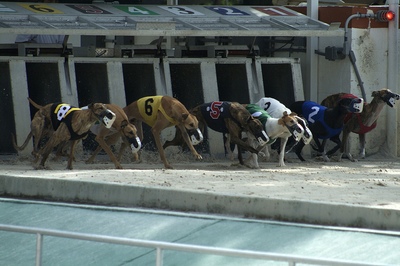
As with all sports, when it comes to betting on greyhound racing bookmakers like to offer customers a choice. It keeps their book looking lively and interesting and their customers happy.
Most of the time punters will want to back a dog to win a given race and for this, there are a small variety of options. You can of course stick with the standard option of backing a specific greyhound by name. But alternatively, you can play the numbers game and opt for a trap betting market instead.
Although there is not an abundance of these, those that are available can provide an attractive alternative to a more traditional greyhound bet.
Trap Betting: Trap Not Dog
The concept of trap betting is perhaps a little out of date now, or at least it is more relevant to betting in a high street shop than online. If on your betting slip you simply write trap 1, you are betting on that trap number winning the race and not a specific greyhound.
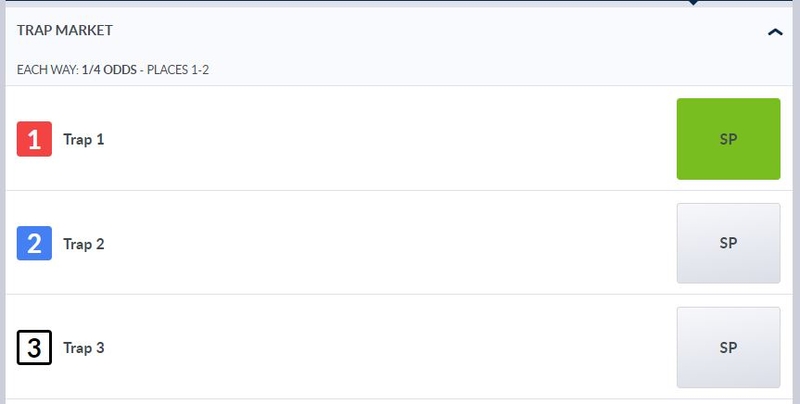
However, if you want to bet on a specific greyhound you must clearly indicate the greyhound’s name on your betting slip. For example, “Trap 1 Springwood Aine”. If you just wrote “Trap 1”, then in the event of any change to trap order (almost unheard of) or if a substitute dog ran instead of your pick, your bet would still stand on whatever dog was in Trap 1.
Of course, when it comes to betting online you are not physically writing a betting slip. Typically you just click a box that always relates to a named, specific dog. However, some betting sites offer betting on a given trap number, whilst some may name the dog but also show a box to tick that will say “no reserves”.
If you back a specific dog, as is usual, and also tick the box “no reserves” if it is available, then your position is clear. If that specific greyhound is a non-runner, your bet is void and therefore your stake is refunded.
However, if your online betting slip relates to a trap number as opposed to named runner, or you do not tick the “no reserves” box if it is listed, things are slightly different. In this instance, should a reserve greyhound come in for your original selection the bet will stand on whatever greyhound runs from that trap whether you like their chances of winning or not.
Benefits of Naming a Greyhound on your Betting Slip
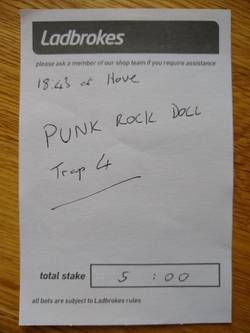 If you are betting online this isn’t likely to be an issue as almost all sites only give you the option of backing a specific dog. However, if you visit a site that does allow you to back a trap or offers a “no reserves” option, generally, you should always name your greyhound and trap number and tick no reserves.
If you are betting online this isn’t likely to be an issue as almost all sites only give you the option of backing a specific dog. However, if you visit a site that does allow you to back a trap or offers a “no reserves” option, generally, you should always name your greyhound and trap number and tick no reserves.
If you have gone through the form of the race then you have chosen a specific greyhound for good reason – or at least a reason even if it’s not a good one! That is the dog you want to back so make sure you don’t inadvertently end up backing a stand-in.
There is however one exception that springs to mind. If you have made a note of the weather or track condition, you may feel that the track will show a bias to the inside or the outer. Therefore, it is possible you may feel that whatever greyhound runs from that location has an increased chance of winning. On this occasion you might want to bet on the trap number irrespective of what dog runs in that trap.
One last thing to note is that just as the issue of trap betting is unlikely to be an issue online, it is also not a problem if you are betting just before the race at the track itself.
When at the track and placing bets on the tote, naming greyhounds is not necessary. The reason for this is that once all greyhounds have been weighed and kennelled it is no longer possible for a reserve to come in. Any changes after weigh-in will result in the trap becoming vacant and your stake refunded.
Other Trap Betting Markets
With betting on a specific trap number instead of a specific dog virtually the same bet in the vast majority of races, it is something a lot of punters do not ever bother with or even think about. Other trap markets do provide a substantially different bet though and these are the ones you may wish to consider next time you are deciding which dog or dogs to back.
Inside v Outside
Although your aim is still to pick the winning trap number, with an inside versus outside bet, your chance of placing a successful bet is significantly higher. This is because rather than being presented with six different betting options (traps 1 to 6), you are simply given the choice of inside or outside. All you have to decide is if you think the winning greyhound will start from the inside three traps (1, 2, 3) or the outer three traps (4, 5, 6).

For a lot of races, there will not be a great difference in the odds between inside and outside so you will do well to get much more than double your money back. While usually not a high-risk bet, it can prove to be an attractive market in a couple of situations. The first scenario where this bet comes in handy is if you are completely torn between two dogs and they are both starting from either the inside or outside. You could, of course, back both but if they are trading at a fairly short price you will likely find that an inside/outside bet will provide better returns.
Another example where you might want to dip into this market is if you think only the three inside or the three outside dogs have any credible chance of winning a particular race. It is unlikely to be successful to individually back three dogs for the win so you can either opt for a riskier forecast/tricast bet or play it safe and go for inside/outside wager as appropriate. You are not going to get a massive payout but if you combine a few inside/outside bets on an accumulator they do quickly add up.
The bookmaker margin with the inside/outside market tends to be around 5-8% so it is a reasonably good value market without being anything exceptional.
Odd v Even
As an alternative to outside versus inside betting, you will also find that odd versus even is offered by some bookmakers. You can probably imagine how this goes but for the avoidance of any doubt, an odd bet covers traps 1, 3 and 5 while an even bet covers traps 2, 4 and 6. If the winning dog starts from one of the three traps your odd or even bet covers then you are a winner. This is another market that often ends up quite even across most races, rather than having one huge favourite. It would only ever end up lopsided if a very strong favourite and the clear second-favourite both start from an odd or an even trap.

This is a market worth utilising in similar situations as the inside/outside bet, mainly if you have two contenders you cannot decide between but both start from an odd or an even trap. Even if you do not particularly rate the third greyhound included in your bet, it still means you can cover your two favourite picks with one bet. It can also provide some decent ‘insurance’ if a race features a runner that blows hot and cold that you are quite wary of. They might not be consistent enough to back outright but with an odd/even bet you can potentially pair them with your favoured option so you won’t lose out should the main dog fails to show up.
As with the inside/outside bets, you can expect the bookies to take a cut of at least 5%, rising to around 8% for this market.
Trap Challenge
The final trap-related betting market at a punter’s disposal is known as a ‘trap challenge’. This is something you will want to consider if you are at a greyhound stadium, or if you plan on watching several races online, as it can provide some extended excitement with just one bet. In this market, punters get to pick which trap will be responsible for the most winners during a certain race meeting. Although most trap challenges will only look at the results from one specific track, you may find some bookies combining a couple of locations as seen below (Yarmouth and Sunderland).
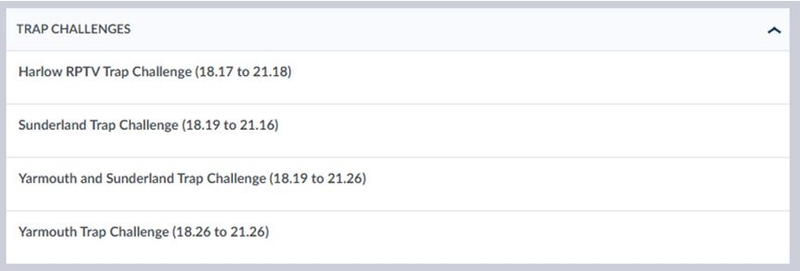
The numbers at the end simply indicate the time of the first and last race of the meeting(s), in other words, which races qualify for the trap challenge. During this period there are likely to be 12 races, as this is a standard number for a greyhound meeting, but you could potentially have a couple more or less.
Regardless of the total number of races though, your objective is always the same, pick the trap that ends up with the highest number of wins. Get it right and you will get a fairly decent return on your stake.
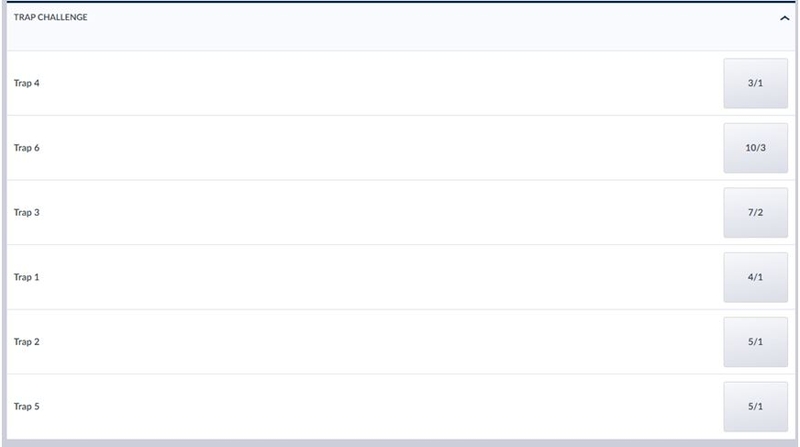
Trap draws for all races are made in advance of the first contest so you can see which dogs will be starting from which position across the entire meeting. As draws are typically random, rather than favourites being awarded a particular trap, it is a market that tends to have little in it in terms of the odds. In the example above, taken from Yarmouth, all traps find themselves trading between 3/1 and 5/1. If you have time, it is best to study all the covered races and weigh up, on balance, which trap is most likely to secure enough winners to allow your bet to win. In a 12-race meeting, the chosen trap will really need to see at least three winners for you to make any money.
In the event that your selected trap ends up tying with another for the number of winners, dead heat rules will usually apply so your payout will be cut in half. This does tend to happen a fair amount so you will not always get the maximum possible return. Also note that should an individual race end up as a dead heat, say between trap 1 and trap 2, then both traps will be awarded a win for that race.
Which Is The Best Trap?
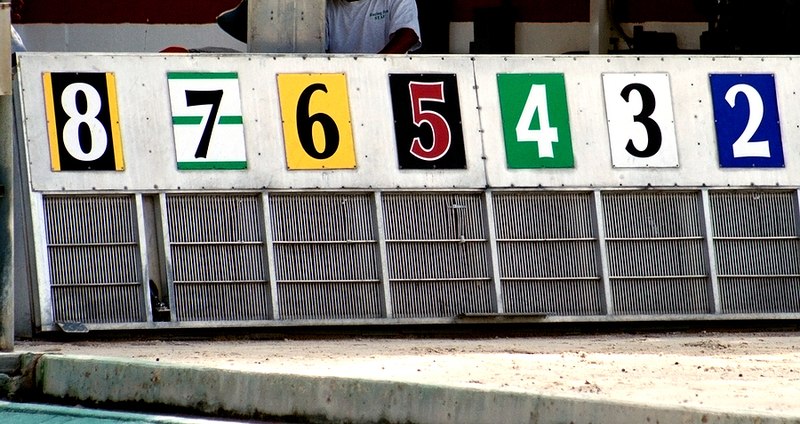
For those of you familiar with Olympic sprint races, you may well have heard that the middle lanes are the optimal place to be. On the inside the corners are too tight, restricting speed and on the very outside there is nobody to visibly chase down, putting runners at a psychological disadvantage. We will not delve deeply into the validity of this widely-held assumption but we mentioned it because there is a strong sense that starting bias exists around when running around an oval circuit.
With greyhound racing, you have an extra consideration given that runners are not fixed to a specific lane and once the race is underway they are free to take up any position on the track. This means low-trap runners that start slowly can find themselves boxed in to the rail and may struggle to find a gap to accelerate into. Looking at data from over 45,000 graded British races across 2021 though, this does not seem to be a real issue as the inside traps lanes outperformed the outside three traps.
| Trap Number | Win Percentage (All Tracks) |
|---|---|
| Trap 1 | 17.06% |
| Trap 2 | 17.42% |
| Trap 3 | 17.31% |
| Trap 4 | 16.73% |
| Trap 5 | 14.66% |
| Trap 6 | 16.82% |
The differences for the most part are fairly insignificant but trap 5 is noticeably poorer than the rest so this does appear to be the worst place to start from. This is not true across all tracks individually but does highlight the general trend. Some tracks have quite a large difference in trap performance, even when looking at performances over several years, so it is always wise to look at specific course figures before betting.
It might be tempting, based on the data above, to say that your betting strategy will be to consistently back inside over outside. This is unlikely to reap any net wins though for two reasons. Firstly, the over-performance from inside runners is only 3.58% and this is less than the bookmaker margin on these bets. You also have to bear in mind that bookies are generally good at factoring any bias into their prices. Should a course favour a particular trap, according to the data, then the bookies will trim the price of dogs starting in that accordingly.
